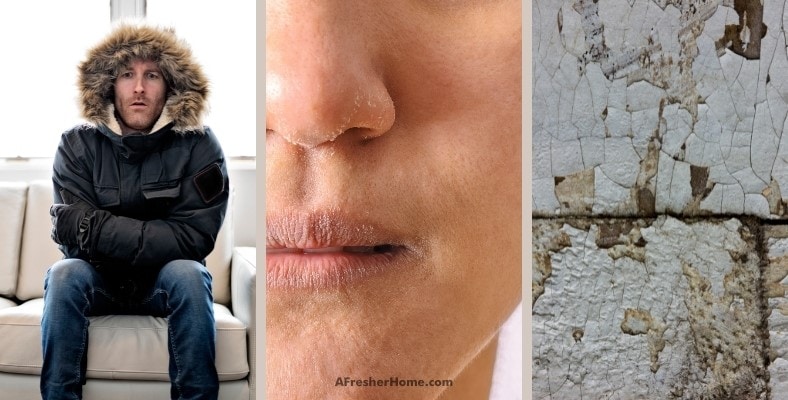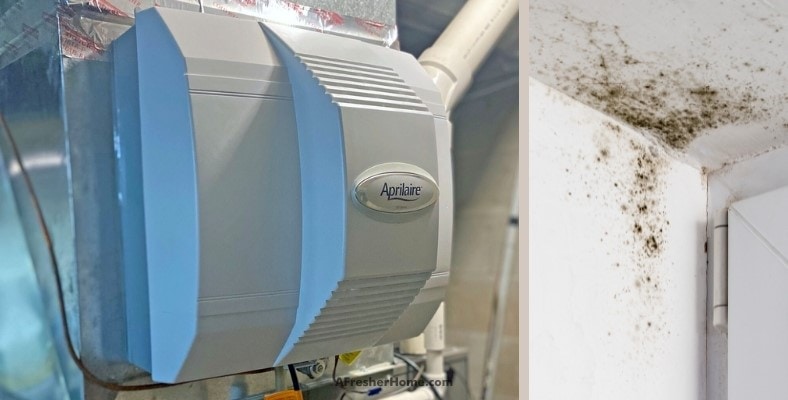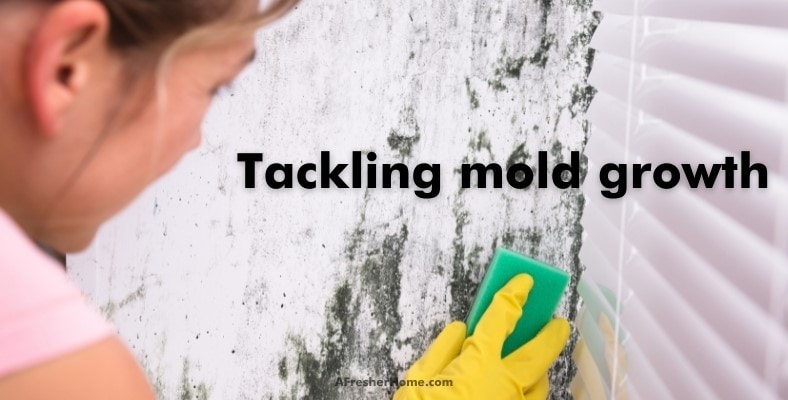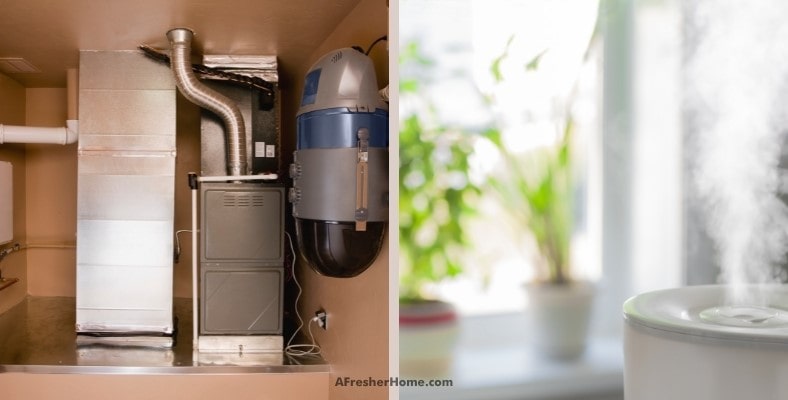Dealing with dry air especially when the winter comes (or in dry climates) is a big deal for a lot of people. But are whole-house humidifiers worth it?
Will they meet your expectations for comfortable air? Read on to find out.
Contents
Are whole house humidifiers worth it?
If you’re currently experiencing cold winter temperatures you may be wondering whether a whole house humidifier is worth it. The majority of people typically introduce a whole house humidifier to tackle a particular problem.
The benefits of a whole house humidifier
For example, you may be fed up with the pain caused by dry skin,or the cracks that have started developing in your wood flooring or furniture. If you’re dealing with any similar problems to those or have respiratory health problems a whole-house humidifier is a great way to get the dryness under control.
The short answer is yes, they’re worth it. A whole house humidifier is ideal if you have the budget and need full house dry air relief – not limited to just one or a few rooms.
By providing a steady flow of moisture to each room a humidifier can help to regulate and control humidity levels. Generally speaking, they’re easy to maintain with certain parts requiring replacement only once a year.
The drawbacks of a whole house humidifier
There are drawbacks associated with a whole house humidifier. In fact, they can sometimes create potential problems.
If most of your humidity problems tend to be limited to one room or certain spaces mainly you may not need one. Rather, a small humidifier that is intended for smaller spaces might be better.
In cases where dry air is prominent in certain areas vs others, adding a whole house humidifier can mean:
- Adding a whole house humidifier when the issue is only prominent in one room may create more discomfort and is wasteful.
- A whole home humidifier can also worsen the air quality by encouraging mold growth if there’s excess moisture in some areas.
To decide whether a whole house humidifier is right for you, you’ll want to first identify the source of your dry air. If you or your loved ones suffer harsh symptoms from allergies while living at home it’s a good option for relief.
Overall, a whole house humidifier is certainly worth it for homeowners that are dealing with a widespread issue that is affecting multiple rooms.
Dry air provides a feeding ground for viruses and microbes. People prone to getting infections or that suffer from respiratory conditions usually find them to be very helpful.
Can whole house humidifiers cause mold?
Yes, in some cases, a whole house humidifier can cause mold to grow due to excess moisture.
This is because mold tends to thrive on cool surfaces. During the winter months there are plenty of cold surfaces and areas for the mold to cling onto. Air ducts tend to be particularly problematic as the source of humidity. When it projects the flow of cool air it can also distribute mold spores.
Over time, the humidifier’s internal components will start to get dirty and dusty, and eventually, mold and mildew will begin to grow.
Aside from the moisture levels, mold may also grow as a result of insufficient maintenance and not removing pre-existing mold. Mold tends to be most noticeable around windows and on the walls.
Dangers of mold growth
Mold growth is dangerous and often the severity of the issue can escalate fairly quickly.
It may not be noticeable but if mold is growing inside the duct system it may blow spores into your home where you or your family can be affected by it. If this mold growth isn’t dealt with as soon as it is noticed it can become harmful resulting in potential health problems.
Those who have inhaled the moldy air will likely begin to experience some kind of respiratory issue due to the poor air quality such as:
- Allergic reactions: Fever-type symptoms (sneezing, runny nose, red eyes, skin rash, etc)
- Asthma attacks triggered
- Eye, skin, nose, throat, and lung irritation
- Excessive coughing or difficulty breathing; shortness of breath or tight chest
- Headaches, various pains, and more
Aside from this, it can also trigger symptoms in some people such as an occasional unexplained cough or itchiness around their eyes.
More serious and extreme consequences can include:
- Infections of the skin or mucous membranes
- Fatigue
- Nervous disorders
- Vomiting, loss of appetite, weight loss
- Chronic bronchitis
- Memory loss, “brain fog”, bleeding lungs, blindness, and brain damage
Tackling mold growth
Conducting proper maintenance will help to reduce the likelihood of mold growth becoming a problem inside your home. Also remember that sometimes mold can be hard to identify because it isn’t very visible and in this case, the problem can be more difficult to attempt to eradicate.
Getting rid of mold or mildew (what works?)
Mildew can often be treated with cleaning products, leaving surfaces unharmed.
Sometimes a good scrubbing bush is needed, too. I’ve been able to clean mildew easily many times using a solution of bleach and water.
Mold, however, is a different story – especially if it has had time to grow further into surfaces. Mold removal is best left to experienced professionals as in many cases walls, floors, ceiling sections, and more will must be replaced. Mold exposure should be dealt with the right way too.
For best results, if you have moisture or high humidity you can prevent mold by ensuring leaks or water sources are completely stopped or by using a dehumidifier. You can also try killing mold with a vinegar and water or bleach and water spray solution.
Does a furnace need a humidifier?
There are some models of humidifiers that work alongside a furnace to distribute the air and humidity evenly throughout the different rooms inside your home. For example, flow-through humidifiers expose the warm air created by the furnace to a constant supply of water.
This water then evaporates as it leaves the furnace entering the environment as a source of air.
You should only run the humidifier when the furnace is functioning. Proceeding to operate the humidifier while the ducts are cold enhances the risk of mold beginning to grow inside the components and then spreading into your home.
Benefits of a furnace humidifier
There are several benefits you’ll get with a furnace humidifier.
- Saving energy: adding a furnace humidifier can help to reduce how much energy is consumed because the stress of the furnace is now eased and it no longer has to work as hard. They generate moist air into the rooms in your home, leaving it feeling warmer. As such, you’re less likely to turn the heat up as much during the day.
- Home maintenance benefits: wood contains moisture and the loss of moisture can mean damage to wood floors such as warping. It can also mean wood furniture cracks as it dries and out window frames can crack due to shrinking. A good humidity level can avoid this.
- The health benefits are clear: Dry skin doesn’t allow the body to stay properly hydrated and can result in skin conditions coming back. A lack of moisture also means you’re more prone to getting sick as it’s harder for your immune system to fight against contaminants. People who suffer from dry eyes or nosebleeds will feel the effects as well, including infants and babies.
Dehydration also happens more quickly when you’re breathing out more moisture due to the air around you having less than it should.







